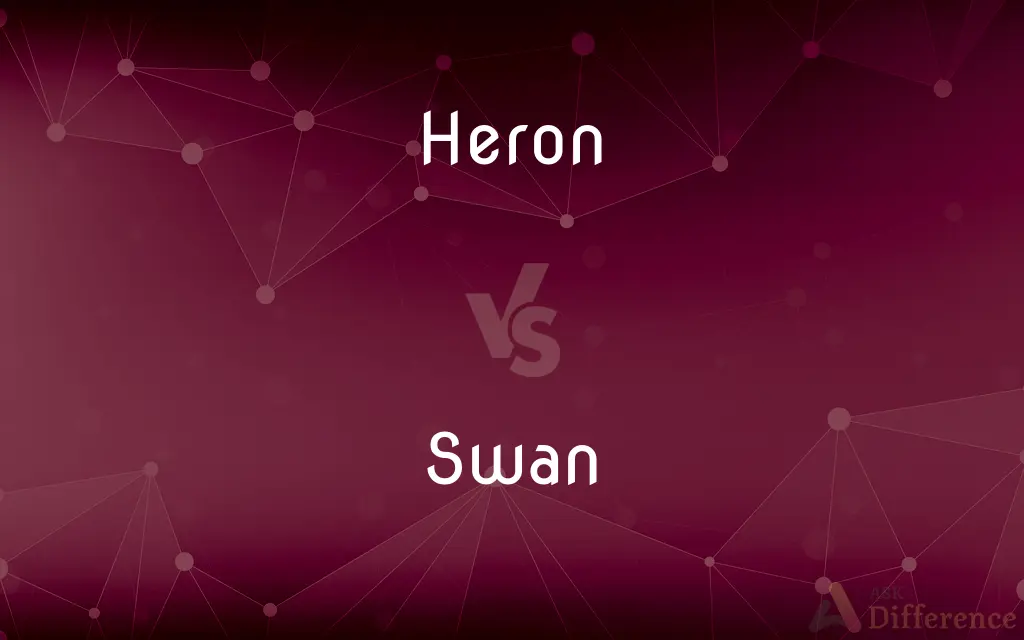Heron vs. Swan — What's the Difference?
By Fiza Rafique & Urooj Arif — Updated on March 10, 2024
Heron is a wading bird known for its long legs and neck, adept at fishing, while swan is a large waterfowl, celebrated for its graceful appearance and strong swimming ability.

Difference Between Heron and Swan
Table of Contents
ADVERTISEMENT
Key Differences
Heron species are characterized by their long legs and necks, enabling them to wade through shallow waters to catch fish. Swans, on the other hand, are notable for their large size, elongated necks, and strong swimming abilities, often dwelling in both fresh and saltwater environments.
While herons engage in solitary fishing, standing still for long periods before striking their prey, swans are more social birds, often seen in pairs or groups, gliding on water surfaces and feeding on aquatic plants.
Herons are diverse in species, displaying a wide range of colors and sizes, and are found globally in varied habitats. Swans are less varied, with fewer species, but they are widely recognized for their white plumage (though not all swans are white) and their symbolic representation in many cultures.
The nesting habits of herons, often high in trees or reeds, contrast with swans' preference for ground nests near water bodies. This reflects their different approaches to protecting their offspring.
Herons are known for their silent and solitary nature, especially when hunting, which is a stark contrast to swans, who are vocal and aggressive in defending their territory and young.
ADVERTISEMENT
Comparison Chart
Habitat
Freshwater and coastal regions worldwide
Lakes, rivers, and coastal areas globally
Behavior
Solitary, stands still to catch fish
Social, swims gracefully, often in pairs or groups
Nesting
In trees or reeds
On the ground near water
Appearance
Long legs and neck, varied colors
Large size, elongated neck, mostly white
Symbolism
Stealth, patience, and solitude
Love, grace, and purity
Compare with Definitions
Heron
Prefers solitary hunting, using stealth and patience.
A heron waits quietly by the water's edge.
Swan
Represents grace and beauty in many cultures.
Swans are often associated with gracefulness in literature and art.
Heron
A bird known for its elongated legs and neck, adept at fishing in shallow waters.
The heron stood motionless before catching a fish.
Swan
A large, elegant waterfowl known for its graceful swimming.
The swan glided across the lake with ease.
Heron
Nests high in trees or reeds, laying eggs in a large nest.
Herons nesting in the treetops can be hard to spot.
Swan
Often mates for life, symbolizing love and fidelity.
Swans are celebrated for their lifelong partnerships.
Heron
Found in diverse habitats around the world.
Herons adapt well to various environments, from wetlands to coastlines.
Swan
Recognizable by its white plumage and long neck.
The white feathers of the swan shimmered under the sun.
Heron
Symbolizes patience and solitude in many cultures.
In folklore, the heron represents a patient and solitary hunter.
Swan
Builds nests on the ground near water, fiercely protecting them.
The swan was guarding its nest on the lake's edge.
Heron
The herons are long-legged, long-necked, freshwater and coastal birds in the family Ardeidae, with 64 recognised species, some of which are referred to as egrets or bitterns rather than herons. Members of the genera Botaurus and Ixobrychus are referred to as bitterns, and, together with the zigzag heron, or zigzag bittern, in the monotypic genus Zebrilus, form a monophyletic group within the Ardeidae.
Swan
Swans are birds of the family Anatidae within the genus Cygnus. The swans' closest relatives include the geese and ducks.
Heron
A large fish-eating wading bird with long legs, a long S-shaped neck, and a long pointed bill.
Swan
A large waterbird with a long flexible neck, short legs, webbed feet, a broad bill, and typically all-white plumage.
Heron
Any of various wading birds of the family Ardeidae, having a long neck, long legs, a long pointed bill, and usually white, gray, or bluish-gray plumage.
Swan
Move about or go somewhere in a casual, irresponsible, or ostentatious way
Swanning around Europe nowadays are we?
Heron
A long-legged, long-necked wading bird of the family Ardeidae.
Swan
Any of various large waterbirds of the genera Cygnus and Coscoroba of the family Anatidae, having webbed feet, a long slender neck, and usually white plumage.
Heron
Any wading bird of the genus Ardea and allied genera, of the family Ardeidæ. The herons have a long, sharp bill, and long legs and toes, with the claw of the middle toe toothed. The common European heron (Ardea cinerea) is remarkable for its directly ascending flight, and was formerly hunted with the larger falcons.
Swan
Swan See Cygnus.
Heron
Greek mathematician and inventor who devised a way to determine the area of a triangle and who described various mechanical devices (first century)
Swan
To travel around from place to place
"Swanning around Europe nowadays, are we?" (Jeffrey Archer).
Heron
Gray or white wading bird with long neck and long legs and (usually) long bill
Swan
To declare; swear. Used in the phrase I swan as an interjection. See Note at vum.
Swan
Any of various species of large, long-necked waterfowl, of genus Cygnus (bird family: Anatidae), most of which have white plumage.
Swan
(figuratively) One whose grace etc. suggests a swan.
Swan
(heraldry) This bird used as a heraldic charge, sometimes with a crown around its neck (e. g. the arms of Buckinghamshire).
Swan
(intransitive) To travel or move about in an aimless, idle, or pretentiously casual way.
Swan
To declare (chiefly in first-person present constructions).
Swan
Any one of numerous species of large aquatic birds belonging to Cygnus, Olor, and allied genera of the subfamily Cygninæ. They have a large and strong beak and a long neck, and are noted for their graceful movements when swimming. Most of the northern species are white. In literature the swan was fabled to sing a melodious song, especially at the time of its death.
Swan
Fig.: An appellation for a sweet singer, or a poet noted for grace and melody; as Shakespeare is called the swan of Avon.
Swan
The constellation Cygnus.
Swan
Stately heavy-bodied aquatic bird with very long neck and usually white plumage as adult
Swan
To declare or affirm solemnly and formally as true;
Before God I swear I am innocent
Swan
Move about aimlessly or without any destination, often in search of food or employment;
The gypsies roamed the woods
Roving vagabonds
The wandering Jew
The cattle roam across the prairie
The laborers drift from one town to the next
They rolled from town to town
Swan
Sweep majestically;
Airplanes were swanning over the mountains
Common Curiosities
Can swans fly?
Yes, swans can fly and are known for their powerful and slow wingbeats.
Are all herons grey?
No, herons come in various colors, including grey, blue, white, and black.
Do swans have predators?
Adult swans have few natural predators due to their size, but eggs and cygnets are vulnerable to predators like foxes.
Do herons migrate?
Some heron species migrate seasonally, while others are resident in their habitat year-round.
What distinguishes a heron's diet?
Herons primarily eat fish, catching them with their sharp beaks.
How long do herons live?
Herons can live up to 15 years in the wild, depending on the species.
How many species of herons are there?
There are about 64 species of herons worldwide.
What colors can swans be besides white?
Swans can also be black, as seen in the Black Swan, or have a mixture of white and black plumage.
What is the typical habitat of a heron?
Herons typically inhabit freshwater and coastal regions around the world.
What is the heron's method of hunting?
Herons hunt by standing still in shallow water and suddenly striking prey with their beak.
What is the significance of a swan's neck?
The swan's long neck aids in feeding underwater and is a symbol of grace and beauty.
Can herons and swans coexist in the same habitat?
Yes, herons and swans can coexist in the same habitats, such as lakes and rivers, though they have different behaviors and dietary needs.
How are swan chicks called?
Swan chicks are called cygnets.
Why are swans often seen in pairs?
Swans often mate for life and are seen in pairs as a reflection of their monogamous relationships.
How do swans communicate?
Swans communicate through a variety of vocalizations and body postures.
Share Your Discovery

Previous Comparison
Add vs. Addition
Next Comparison
Vice vs. VersusAuthor Spotlight
Written by
Fiza RafiqueFiza Rafique is a skilled content writer at AskDifference.com, where she meticulously refines and enhances written pieces. Drawing from her vast editorial expertise, Fiza ensures clarity, accuracy, and precision in every article. Passionate about language, she continually seeks to elevate the quality of content for readers worldwide.
Co-written by
Urooj ArifUrooj is a skilled content writer at Ask Difference, known for her exceptional ability to simplify complex topics into engaging and informative content. With a passion for research and a flair for clear, concise writing, she consistently delivers articles that resonate with our diverse audience.













































